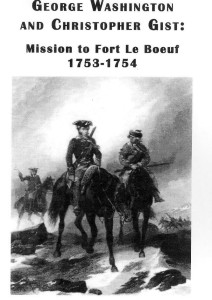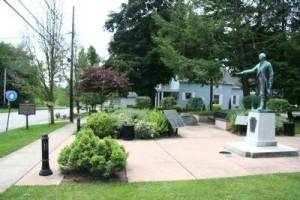Washington Statue Park
The fact that George Washington played a key role in the history of Waterford, PA is an honor in itself. Washington was accompanied by an older and more experienced frontiersman who had a no-nonsense approach to the Indians. On this journey, Gist saved Washington’s  life on two separate occasions. Besides Gist, Washington also took Barnaby Currin and Jon M‟Guire, who lived by trading with the Indians. Henry Stewart and William Jenkins served him on the trip and he took John Davidson to act as his interpreter with the French and Jacob Van Vraam, as an Indian interpreter. He also took four Indian sachems for safe conduct through hostile territory. They were Tanacharisson, whom he called the Half King, White Thunder, Kakakee, and Guiasuta, the Hunter. Captain LeForce and three French soldiers joined him at Venango without an invitation. They arrived at Fort Le Boeuf on 11 December 1753. Jacques Legardeur de Saint-Pierre, commandant at Fort Le Boeuf, received Washington politely, but rejected his blustering ultimatum. He permitted him to stay at the fort for three days and gave him a letter to deliver back to Dinwiddie.
life on two separate occasions. Besides Gist, Washington also took Barnaby Currin and Jon M‟Guire, who lived by trading with the Indians. Henry Stewart and William Jenkins served him on the trip and he took John Davidson to act as his interpreter with the French and Jacob Van Vraam, as an Indian interpreter. He also took four Indian sachems for safe conduct through hostile territory. They were Tanacharisson, whom he called the Half King, White Thunder, Kakakee, and Guiasuta, the Hunter. Captain LeForce and three French soldiers joined him at Venango without an invitation. They arrived at Fort Le Boeuf on 11 December 1753. Jacques Legardeur de Saint-Pierre, commandant at Fort Le Boeuf, received Washington politely, but rejected his blustering ultimatum. He permitted him to stay at the fort for three days and gave him a letter to deliver back to Dinwiddie.
In 1922, the citizens of Waterford honored his visit in 1753, with a statue purchased at a fee of $13,000 and placed in the center of the street for all to see. The dedication of that statue brought over 10,000 people into this tiny town for the ceremony. In time, George was the subject of school boy pranks, (dressing him up) but most importantly, the fear that the statue would be destroyed due to traffic accidents became a real threat.
Washington Park was constructed to honor not only the visit of George Washington to the French Fort LeBoeuf. By reason of their discovery of the St. Lawrence and the Mississippi, the French claimed all territory watered by these rivers, and by 1751 it was apparent to the French they would meet difficulties in maintaining their position. In the spring of 1753 they sent forces to erect fortifications, of which Fort LeBoeuf was one. On December 11, 1753, George Washington, then a Major in the British Army, arrived here as an emissary of Governor Dinwiddie of Virginia to inform them they were trespassing on British soil. However, they gave him no satisfaction; their refusal, to withdraw from British territory undoubtedly helped bring about the subsequent French and Indian War, and in 1759 the French hastily evacuated and burned Fort LeBoeuf.
The British took possession and built a new fort. In 1763 the Indians surrounded the fort and set fire to it. A third fort flying the American Flag was built in 1794, and two years later the American Block House was built for better protection of the settlers. Later, it was used variously as a prison, store house, post office, hotel, and residence. It burned March 21, 1868.
The Daughters of the American Colonists were most fortunate in securing this bit of land on which the Block House stood, and in being able to preserve it for all time. It was decided not to restore the block house but to restore and beautify the grounds. The cellar was cleaned out and rebuilt, and the old well was reconstructed. Flagstones, trees, an old oaken bucket, a sun-dial of ancient design, the well-sweep, two log benches, a flag holder with a silk French, English and Pennsylvania banner accompanied by the Stars and Stripes, were given by individuals, Chapters and State Societies, as an expression of loyalty to the father of their country.
In 1945 the statue of George Washington, the only one existing depicting him as a young man, was moved from its original site by the Pennsylvania Historical Commission onto the Fort LeBoeuf Chapter Washington Memorial Lot.
The gifts were accepted in the name of the National Society and then turned over in trust with the site itself to the perpetual care of the Fort LeBoeuf Historical Society.